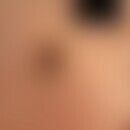Synonym(s)
DefinitionThis section has been translated automatically.
Distension of the finger end-limbs (clubbed fingers) with high-grade soft tissue thickening, usually in chronic hypoxemia due to cardiac or pulmonary disease (bronchiectasis, interstitial lung disease, pulmonary tuberculosis, or lung carcinoma). Unilateral drumstick fingers come past aneurysm of the great brachial arteries or arteriovenous aneurysm of the involved extremity.
Drumstick fingers are often associated with clock glass nails (rounded anteriorly convex finernails).
Occurrence/EpidemiologyThis section has been translated automatically.
Drumstick fingers may be signs of a rare genodermatosis (primary hypertrophic osteoarthropathy). Occurring as an isolated anomaly, these congenital drumstick fingers (acropachy, isolated congenital/ OMIM: 119900) are characterized by enlarged terminal finger and toe segments. They are often associated with clock glass nails. No other anomalies are present.
Drumstick fingers are observed in a number of diseases. Most notably, they include the following:
- Pulmonary diseases: e.g. bronchiectasis, emphysema, cystic fibrosis, bronchial carcinoma, pleural mesothelioma.
- Cardiac diseases: e.g. cyanotic heart defects (congenital cardiac vitias with right-to-left shunt, Eisenmenger syndrome), pulmonary hypertension. (1)
- Liver diseases: Alcohol was found to be the most common cause in men in India.
- Autoimmune diseases: Drumstick fingers occur in rare cases but also in some autoimmune diseases such as Crohn's disease, ulcerative colitis, coeliac disease (sprue) or PBC.
- Paraneoplasia: Drumstick fingers are in some cases signs of hypertrophic osteoarthropathy, which usually occurs as paraneoplasia (accompanying symptoms of tumors, e.g. bronchial carcinoma).
You might also be interested in
EtiopathogenesisThis section has been translated automatically.
Not clear. There is evidence that a humoral substance in the terminal joints of the phalanges causes vascular dilatation.
ClinicThis section has been translated automatically.
The finger and foot end joints are bulbous due to the proliferation of connective tissue with increase in soft tissue mass - especially dorsally.
DiagnosisThis section has been translated automatically.
The diagnosis can be confirmed by x-ray of the fingers / feet.
LiteratureThis section has been translated automatically.
literature
- Herold G et al (2018) Internal Medicine. 151, 338
- Anschütz F (1978) The physical examination. 167-168
- Kasper DL et al (2015) Harrison's Principles of Internal Medicine. 2244-2245
- Loscalzo J et al (2011) Harrison's pulmonary medicine and intensive care. 26
- Matthys H et al (2008) Clinical Pneumology 45-46
Outgoing links (1)
Watch glass nails;Disclaimer
Please ask your physician for a reliable diagnosis. This website is only meant as a reference.




